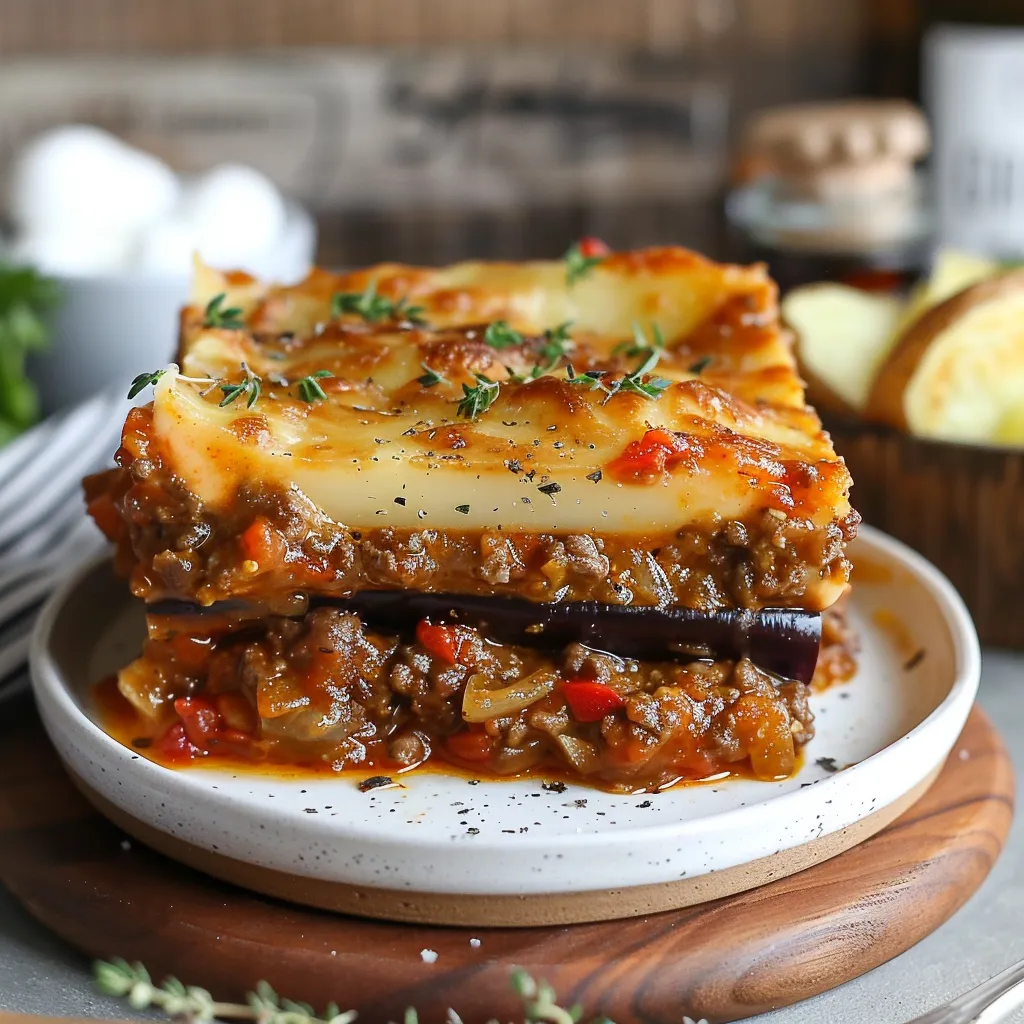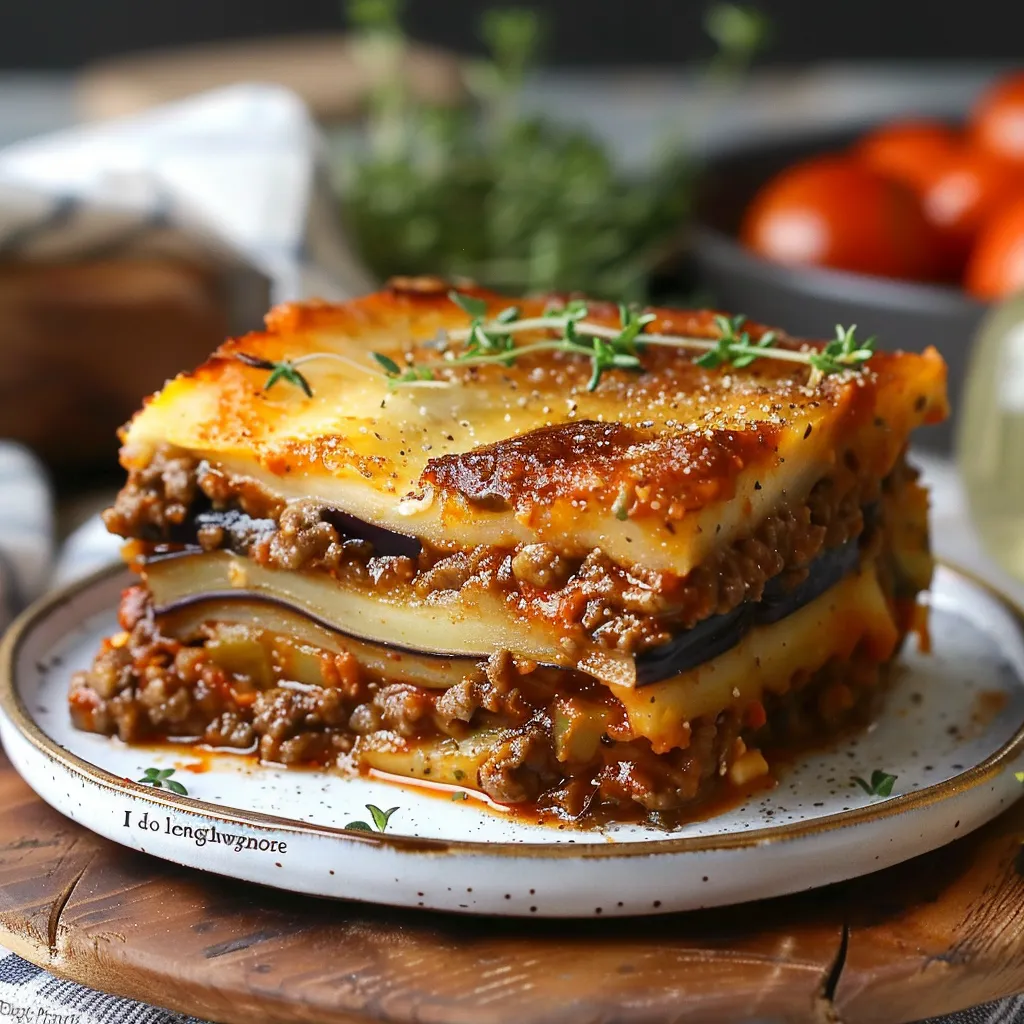 Pin it
Pin it
This outrageously delicious Greek Moussaka transforms simple ingredients into layers of Mediterranean magic. The combination of tender vegetables, savory beef, and creamy béchamel creates a dish that balances rustic comfort with elegant flavors.
I first made this moussaka for a dinner party with friends who had just returned from Greece. Their eyes lit up with recognition at the first bite, and now it's requested at every gathering.
Ingredients
- Ground Beef: Forms the heart of the dish, provides rich flavor and hearty texture; look for lean beef for best results
- Eggplant slices: Create the signature Mediterranean base, soak up flavors beautifully, and provide subtle sweetness
- Potatoes: Add substance and comfort to the base layer; select starchy baking potatoes for best texture
- Zucchini: Brings freshness and color; choose firm, medium-sized ones for best results
- Béchamel sauce: Creates the luxurious creamy topping; never skip this crucial component
- Pecorino Romano cheese: Adds sharp, salty notes throughout the dish; freshly grated makes a significant difference
- Cinnamon: Provides the quintessential Greek aromatic note that distinguishes an authentic moussaka
- Red wine: Deepens the beef flavor and adds complexity; use a wine you would enjoy drinking
Step-by-Step Instructions
- Prepare the Beef Layer:
- Heat olive oil in a large pot over medium heat until shimmering. Add diced onions and cook for 5 minutes until they turn translucent and begin to caramelize at the edges. Add garlic and cook for another minute until fragrant. Add ground beef, breaking it apart until no pink remains. Stir in tomato paste and cook for 2 minutes. Pour in wine and let it bubble, scraping browned bits from the pan bottom. Add passata, stock, herbs, and spices. Simmer for 30 minutes, stirring occasionally, until the sauce thickens and flavors meld completely.
- Prepare and Fry Vegetables:
- Lay sliced vegetables on paper towels and salt the eggplant to draw out moisture. Pat all vegetables dry thoroughly. Fry potatoes at 300°F until tender and golden, about 3 minutes per side. Increase oil to 340°F and fry zucchini until lightly golden, about 2 minutes per side. Finally, fry eggplant until browned and tender, about 3 minutes per side.
- Create the Béchamel:
- Melt butter in a pot over medium heat. Add flour all at once and stir to form a paste. Gradually add milk while whisking constantly. Cook until sauce thickens and coats the back of a spoon. Remove from heat, add seasonings and cheese, and stir until incorporated. Quickly whisk in egg yolks while sauce is hot but not boiling.
- Assemble and Bake:
- Layer potatoes in a baking dish, sprinkle with herbs and cheese. Add zucchini, half the eggplant, and pour beef mixture evenly. Top with remaining eggplant. Pour béchamel over the dish, sprinkle with additional cheese, and bake until golden and bubbling, about 40 minutes. Let rest before serving.
The first time I made this moussaka, I tried to rush the vegetable frying step. Big mistake. Taking the time to properly prepare and fry each vegetable separately transforms them from simple ingredients into flavor vehicles with perfect texture. My family noticed immediately when I started taking this step seriously, commenting on how much more delicious and authentic the dish had become.
Storage and Reheating
Moussaka actually improves with time as flavors meld and deepen. You can refrigerate leftovers for up to 3 days in an airtight container. The béchamel will firm up when cold but becomes creamy again when reheated. For best results, reheat individual portions in the microwave at 70% power to prevent the béchamel from separating or the vegetables from becoming mushy. Alternatively, reheat the entire dish covered with foil in a 325°F oven until warmed through, about 20 minutes.
Make Ahead Options
Moussaka is perfect for entertaining because nearly every component can be prepared in advance. Prepare the meat sauce up to two days ahead and refrigerate. The vegetables can be fried and stored between layers of paper towels in the refrigerator overnight. Even the béchamel can be made a day ahead, though you'll need to gently reheat it and whisk well before assembling. Assemble the entire dish up to 24 hours before baking, cover tightly with plastic wrap, and refrigerate. Allow the dish to come to room temperature for 30 minutes before baking and add about 10 minutes to the baking time.
Lighter Variations
While traditional moussaka calls for frying the vegetables, you can reduce the oil significantly by roasting them instead. Brush eggplant and zucchini slices with olive oil, season with salt and pepper, and roast at 425°F for about 20 minutes until tender and lightly browned. For the potatoes, boil slices for 5 minutes until just tender before layering in the dish. The flavor profile will change slightly, becoming less rich but still delicious. You can also lighten the béchamel by using 2% milk instead of whole, though the sauce will be slightly less creamy.
 Pin it
Pin it
This moussaka is a labor of love that transforms humble ingredients into an unforgettable centerpiece. Enjoy every layer!
Frequently Asked Questions
- → How can I avoid a watery Moussaka?
To prevent a watery dish, ensure you salt and press the moisture out of the vegetables with paper or tea towels before cooking. Additionally, allow the Moussaka to rest after baking for at least 15 minutes to set.
- → What kind of cheese works best for the Béchamel sauce?
Traditionally, Kefalotyri cheese is used, but Pecorino Romano or Parmesan are excellent substitutes. Choose a hard, salty cheese with strong flavor.
- → Can I bake the vegetables instead of frying?
Yes, you can bake the eggplant, zucchini, and potatoes with a light drizzle of olive oil at 400°F (200°C) until golden and tender. This is a healthier alternative to frying.
- → How do I know when the Béchamel sauce is ready?
The Béchamel sauce is ready when it is thick, creamy, and lump-free. Adding cheese and whisking in egg yolks off the heat will give it a silky finish.
- → Can I make Moussaka ahead of time?
Yes, you can prepare the components and assemble the Moussaka up to a day in advance. Cover and store in the refrigerator, then bake fresh when ready to serve.
- → What can I substitute for red wine in the beef layer?
If you prefer not to use red wine, replace it with an equal amount of beef stock for a rich and savory flavor.
